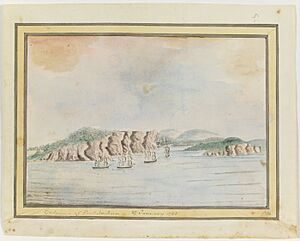William Bradley (Royal Navy officer) facts for kids
Quick facts for kids
William Bradley
|
|
|---|---|
| Born | 14 November 1758 Portsmouth, Hampshire, England |
| Died | 13 March 1833 (aged 74) Le Havre, France |
| Allegiance | |
| Service/ |
|
| Years of service | 1772 to 1812 |
| Rank | Rear-Admiral (struck off) |
| Commands held | HMS Comet HMS Champion HMS Plantagenet |
| Battles/wars | Glorious First of June |
| Spouse(s) |
Sarah Witchell
(m. 1787) |
William Bradley was a British naval officer and cartographer (map-maker). He was an important officer in the First Fleet, which sailed to Australia to start a new colony.
During this journey, Bradley created many maps of the coastline. He was also one of the first settlers to meet and study the Aboriginal people. He learned about their customs and way of life.
Later in his career, Bradley faced challenges with his health. He became a successful ship commander but eventually retired from the navy. He spent his final years living in France.
Contents
William Bradley was born on November 14, 1758, in Portsmouth, England. His family had strong ties to the Royal Naval Academy. His father and younger brother both taught there.
Bradley joined the Royal Navy in 1772 when he was about 14 years old. He served on several ships and became a lieutenant in 1778. He continued his service until 1786. Then, he joined a ship called HMS Sirius.
His time during the American Revolutionary War was not very active. However, his role on the Sirius became very important. This ship was part of the First Fleet, which was heading to colonize Australia.
Exploring Australia
In 1788, Bradley focused on exploring the new land. He worked with John Hunter to map the Sydney Harbour coastline. They often spent long periods away from the main colony. They surveyed the coast and the surrounding areas.
Bradley was a careful observer. He wrote a detailed journal that started in 1786. It described the fleet's journey to Australia. He wrote about ports, other ships, and the weather. He also shared his thoughts on the new colony.
He was very interested in the Aboriginal people and nature. At first, he had a positive view of the local inhabitants. However, some experiences changed his mind. On October 1, 1788, he wrote in his journal. He explained that his good opinions had changed. He felt they were only friendly when they felt safe or when the settlers were armed.

In October 1788, Bradley sailed around the world. His ship went to the Cape of Good Hope to get supplies for the colony. He returned in March 1789. Bradley then helped repair the Sirius. He also continued his mapping work and observed more Aboriginal communities.
His view of the Aboriginal people became less positive over time. In November 1789, he took part in an event to capture local Aboriginal leaders, Colbee and Bennelong. Bradley described this duty as very unpleasant.
In 1790, the Sirius and HMS Supply sailed to Norfolk Island. They were looking for more food supplies. While there, the Sirius was caught in a storm and wrecked. Bradley and his crew were stranded on the island for eleven months. During this time, they mapped the land extensively.
In 1791, Bradley returned to Port Jackson. From there, he sailed to the Philippines and then back to Britain. The ships arrived in 1792. The crews faced a court-martial for the loss of the Sirius. However, they were honorably found not guilty.
Bradley was promoted to master and commander in 1791. In 1793, he commanded the ship HMS Comet. This was part of the Channel Fleet under Lord Howe.
In May 1794, a year after the French Revolutionary Wars began, Howe's fleet chased a French convoy. This led to the battle of the Glorious First of June. Howe's fleet won against the French. Bradley helped by relaying signals to the large fleet. He did such a good job that he was promoted to post-captain after the battle.
Bradley later commanded the ship HMS Cambrian. He served on the Halifax station for eight years. He returned to Britain in 1802. In 1805, he took command of HMS Plantagenet. During these commands, he mainly performed convoy and blockade duties.
Final Years
In 1809, Bradley began to experience health problems. He was removed from active service. Later, he worked in an impress unit. In 1812, he had another health issue and retired as a rear-admiral.
A few years later, Bradley faced a personal challenge. He was involved in a minor incident related to postal services. He was arrested and brought to court. His behavior was noted as very unusual. He was eventually exiled from Britain.
In 1816, Bradley moved to Le Havre, France. He spent his time working on inventions. He hoped to create a device to easily calculate longitude. He wished this invention would allow him to return to Britain. However, this never happened. His family also tried to get his sentence reversed due to his health, but they were unsuccessful.
Bradley passed away in France in March 1833. He left behind three daughters and a son. His wife described him as a kind husband and loving father. Other officers sometimes found him difficult to get along with.
Bradley left a large collection of work. It includes surveys, maps, personal notes, and sketches of the coasts and Aboriginal people of the Sydney area. This work is still available at the State Library of New South Wales.
His name is remembered in Bradleys Head in Sydney Harbour.
See also
- First Fleet
- Journals of the First Fleet
Images for kids




